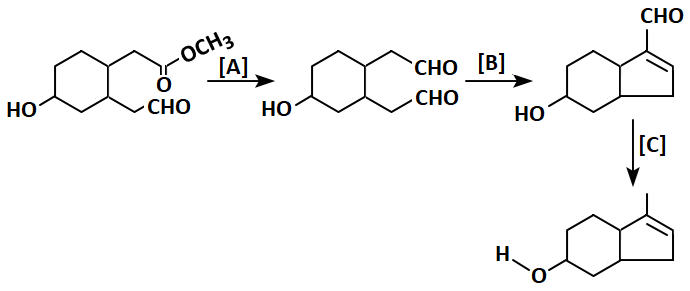Select Chapter Topics:
Which compound undergoes decarboxylation most readily under mild conditions?
1.

2.

3.

4.





Subtopic: Name Reaction |
From NCERT
Please attempt this question first.
Hints
Please attempt this question first.
The compound, among the following that cannot give a positive Tollen's test is:
| 1. |  |
2. |  |
| 3. |  |
4. |  |
Subtopic: Aldehydes & Ketones: Preparation & Properties |
From NCERT
Please attempt this question first.
Hints
Please attempt this question first.
Consider the Cannizzaro reaction given below:

The slowest step in this reaction is:
1. attack of \(^-OH\) at the carbonyl group.
2. transfer of hydride to the carbonyl group.
3. abstraction of a proton from the carboxylic acid.
4. deprotonation of \(PhCH_2OH.\)

The slowest step in this reaction is:
1. attack of \(^-OH\) at the carbonyl group.
2. transfer of hydride to the carbonyl group.
3. abstraction of a proton from the carboxylic acid.
4. deprotonation of \(PhCH_2OH.\)
Subtopic: Aldehydes & Ketones: Preparation & Properties |
50%
From NCERT
Please attempt this question first.
Hints
Please attempt this question first.
An organic compound that neither reacts with neutral ferric chloride solution nor with Fehling's solution, but reacts with a Grignard reagent and gives a positive iodoform test, is:
| 1. |  |
2. |  |
| 3. |  |
4. |  |
Subtopic: Acid Derivatives - Preparation, Properties & Uses |
From NCERT
Please attempt this question first.
Hints
Please attempt this question first.
Identify compound A that starts the following reaction sequence:


| 1. |  |
2. |  |
| 3. |  |
4. |  |
Subtopic: Aldehydes & Ketones: Preparation & Properties |
From NCERT
Please attempt this question first.
Hints
Please attempt this question first.
In the following reaction sequence, predict the structure of the final product Y.


| 1. |  |
2. |  |
| 3. |  |
4. |  |
Subtopic: Isomers & Reaction Mechanism | Carboxylic Acids: Preparation & Properties |
From NCERT
Please attempt this question first.
Hints
Please attempt this question first.
In which one of the following cases will \(\alpha\)-hydrogen NOT be abstracted on treatment with one equivalent of base?
| 1. |  |
2. |  |
| 3. |  |
4. |  |
Subtopic: Aldehydes & Ketones: Preparation & Properties | Carboxylic Acids: Preparation & Properties |
From NCERT
Please attempt this question first.
Hints
Consider the following sequence of reactions:

Identify \(\mathrm{A,B,}\) and \(\mathrm{C}\) in the reaction sequence:

Identify \(\mathrm{A,B,}\) and \(\mathrm{C}\) in the reaction sequence:
| 1. | \(\mathrm{A:DiBAL\text-H,}\) \(\mathrm{B:NaOH\text{ (dil)},}\) \(\mathrm{C:Zn\text-Hg/HCl}\) |
| 2. | \(\mathrm{A:LiAlH_4,}\) \(\mathrm{B:KOH\text{ (alcoholic)},}\) \(\mathrm{C:NH_2\text-NH_2/KOH}\) |
| 3. | \(\mathrm{A:DiBAL\text-H,}\) \(\mathrm{B:NaOH\text{ (dil)},}\) \(\mathrm{C:NH_2\text-NH_2/KOH}\) |
| 4. | \(\mathrm{A:NaBH_4,}\) \(\mathrm{B:KOH\text{ (aqueous)},}\) \(\mathrm{C:Zn\text-Hg/HCl}\) |
Subtopic: Aldehydes & Ketones: Preparation & Properties |
From NCERT
JEE
Please attempt this question first.
Hints
Please attempt this question first.
Given below are two statements:
| Statement I: | Aldehydes react with one equivalent of monohydric alcohol in the presence of dry HCl to yield acetals. |
| Statement II: | Acetals and ketals are hydrolyzed with aqueous mineral acids to yield corresponding aldehydes and ketones respectively. |
| 1. | Both Statement I and Statement II are correct. |
| 2. | Both Statement I and Statement II are incorrect. |
| 3. | Statement I is incorrect and Statement II is correct. |
| 4. | Statement I is correct and Statement II is incorrect. |
Subtopic: Isomers & Reaction Mechanism |
From NCERT
Please attempt this question first.
Hints
Please attempt this question first.
Identify the reaction(s) which do not give n-propyl benzene as a major product:
Choose the correct answer from the options given below:
1. A only
2. A and B only
3. C and D only
4. D only
| A. |  |
| B. |  |
| C. |  |
| D. |  |
Choose the correct answer from the options given below:
1. A only
2. A and B only
3. C and D only
4. D only
Subtopic: Name Reaction |
From NCERT
To view explanation, please take trial in the course.
NEET 2026 - Target Batch - Vital
Hints
To view explanation, please take trial in the course.
NEET 2026 - Target Batch - Vital




